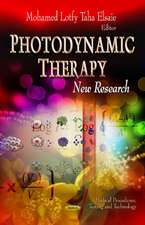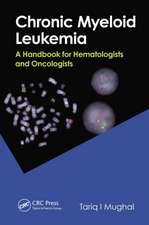Novel Developments in Stem Cell Mobilization: Focus on CXCR4
Editat de Stefan Fruehauf, W. Jens Zeller, Gary Calandraen Limba Engleză Paperback – 11 apr 2014
| Toate formatele și edițiile | Preț | Express |
|---|---|---|
| Paperback (1) | 1105.77 lei 43-57 zile | |
| Springer – 11 apr 2014 | 1105.77 lei 43-57 zile | |
| Hardback (1) | 1111.26 lei 43-57 zile | |
| Springer – 14 feb 2012 | 1111.26 lei 43-57 zile |
Preț: 1105.77 lei
Preț vechi: 1163.97 lei
-5% Nou
Puncte Express: 1659
Preț estimativ în valută:
211.66€ • 229.98$ • 177.91£
211.66€ • 229.98$ • 177.91£
Carte tipărită la comandă
Livrare economică 21 aprilie-05 mai
Preluare comenzi: 021 569.72.76
Specificații
ISBN-13: 9781489993762
ISBN-10: 1489993762
Pagini: 512
Ilustrații: XIV, 498 p.
Dimensiuni: 155 x 235 x 27 mm
Greutate: 0.7 kg
Ediția:2012
Editura: Springer
Colecția Springer
Locul publicării:New York, NY, United States
ISBN-10: 1489993762
Pagini: 512
Ilustrații: XIV, 498 p.
Dimensiuni: 155 x 235 x 27 mm
Greutate: 0.7 kg
Ediția:2012
Editura: Springer
Colecția Springer
Locul publicării:New York, NY, United States
Public țintă
Professional/practitionerCuprins
Preface.- Preclinical Experience with AMD3100 for Mobilization of Hematopoietic Stem and Progenitor Cells.- Molecular Pharmacology of CXCR4 Inhibition.- Combination Strategies for Stem Cell Mobilization Targeting CXCR4 and S1P Receptors.- Should We Stay Or Should We Go Now?
Cell Adhesion and Mobilization Pathways of Hematopoietic Cellls.- Role of the CXCR4/CXCL12 Axis in Hematopoietic Stem Cell Trafficking.- Early Studies of AMD3100/Plerixafor in Healthy Volunteers.- The Current Role of Plerixafor in Stem Cell Mobilization for Hematopoietic Stem Cell Transplantation.- Relevance and Clinical Implications of Tumor Cell Mobilization in Autologous Transplantation of Multiple Myeloma and non Hodgkin's lymphoma.- Plerixafor – Data from the Compassionate Use Program.- Stem Cell Mobilization with Chemomobilization plus Plerixafor in Hard-To-Mobilize Patients – The Experience at Kuopio University Hospital, Finland.- Blood Stem Cell Mobilization in Solid Tumors - Experience with Plerixafor and Alternative Ways of Hematopoietic Stem Cell Mobilization.- Mobilization with Chemotherapy+G-CSF+Plerixafor in Europe- the Italian experience.- Experience with Plerixafor in Poor Mobilizers.- CXCR4 Antagonists.- Application of CXCR4-Inhibitors in Leukemia.- CXCR4 Antagonists for the Treatment of CML.- Targeting CXCR4 in Chronic Lymphocytic Leukemia (CLL): Preclinical Rationale and Early Clinical Experience.- CXCR4-Blockade for Treatment of Breast Cancer.- Molecular Imaging of CXCR4 Receptor Expression in Tumors.- Potential Use of CXCR4 Antagonists to Mobilize Endothelial and Mesenchymal Stem Cells.- Strategies to Enhance Hematopoietic Stem Cell Engraftment Following Transplantation.- Mobilization for Gene Therapy.- Index.
Cell Adhesion and Mobilization Pathways of Hematopoietic Cellls.- Role of the CXCR4/CXCL12 Axis in Hematopoietic Stem Cell Trafficking.- Early Studies of AMD3100/Plerixafor in Healthy Volunteers.- The Current Role of Plerixafor in Stem Cell Mobilization for Hematopoietic Stem Cell Transplantation.- Relevance and Clinical Implications of Tumor Cell Mobilization in Autologous Transplantation of Multiple Myeloma and non Hodgkin's lymphoma.- Plerixafor – Data from the Compassionate Use Program.- Stem Cell Mobilization with Chemomobilization plus Plerixafor in Hard-To-Mobilize Patients – The Experience at Kuopio University Hospital, Finland.- Blood Stem Cell Mobilization in Solid Tumors - Experience with Plerixafor and Alternative Ways of Hematopoietic Stem Cell Mobilization.- Mobilization with Chemotherapy+G-CSF+Plerixafor in Europe- the Italian experience.- Experience with Plerixafor in Poor Mobilizers.- CXCR4 Antagonists.- Application of CXCR4-Inhibitors in Leukemia.- CXCR4 Antagonists for the Treatment of CML.- Targeting CXCR4 in Chronic Lymphocytic Leukemia (CLL): Preclinical Rationale and Early Clinical Experience.- CXCR4-Blockade for Treatment of Breast Cancer.- Molecular Imaging of CXCR4 Receptor Expression in Tumors.- Potential Use of CXCR4 Antagonists to Mobilize Endothelial and Mesenchymal Stem Cells.- Strategies to Enhance Hematopoietic Stem Cell Engraftment Following Transplantation.- Mobilization for Gene Therapy.- Index.
Textul de pe ultima copertă
Recently, the CXCR4/CXCL12-axis has been recognized as one of the pivotal adhesion pathways by which hematopoietic stem cells are retained in the bone marrow. CXCR4 antagonists with different chemical specification are being developed. Pharmacology research guides the way to the rational development of effective antagonists. One antagonist, plerixafor, is now clinically approved for stem cell mobilization of lymphoma and myeloma patients. This progress allows patients to receive potentially life-saving treatment which could not have been administered otherwise. Through early clinical studies it was recognized that CXCR4 antagonists also mobilize malignant hematopoietic cells, i.e. leukemia cells. In preclinical studies, a sensitization of mobilized leukemic cells to standard cytotoxic chemotherapy could be shown.
CXCR4 antagonists are an exciting new class of compounds which are also used for the mobilization of angiogenic cells or for the treatment of solid tumors. This book provides concise reviews of novel developments, as well as possible future developments on CXCR4.
CXCR4 antagonists are an exciting new class of compounds which are also used for the mobilization of angiogenic cells or for the treatment of solid tumors. This book provides concise reviews of novel developments, as well as possible future developments on CXCR4.
Caracteristici
A concise review of the current status of knowledge and future developments of CXCR4 will be presented
Contributors are internationally leaders in the field
A comprehensive treatment of the subject with numerous color illustrations
Includes supplementary material: sn.pub/extras
Contributors are internationally leaders in the field
A comprehensive treatment of the subject with numerous color illustrations
Includes supplementary material: sn.pub/extras











